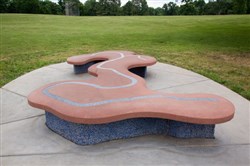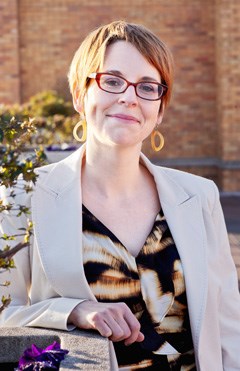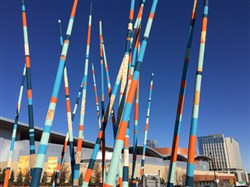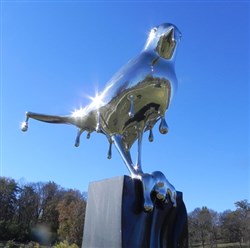VOL. 39 | NO. 52 | Friday, December 25, 2015
Is it great art or a waste of taxpayer funds?
By Linda Bryant | Correspondent
Nashville’s publically-funded art projects have reaped national awards and attracted international attention in the past four years, particularly for the creativity and usefulness of its budding bike rack program.
Public art is heating up in Music City, finding more fans despite some pushback by residents who think it’s a waste of taxpayers’ money.
The most current high-profile project is “Stix,’’ a $750,000 abstract sculpture under installation at the Korean Veterans Boulevard Roundabout, adjacent to the Music City Center convention center.
The construction phase has been prolonged because of the complications of drilling more than two dozen 12-foot holes into solid limestone. Those holes are for 27 brightly painted red cedar poles that stand 70-feet tall.
The poles, which look somewhat like giant pieces of the old fashioned children’s game pick-up sticks, are spaced in an irregular organic pattern throughout the surface area of the roundabout.
“Stix,’’ doubles the $370,000 it took to build the “Ghost Ballet’’ steel sculpture on the Cumberland River’s east bank. “Ghost Ballet,’’ with its wild red roller coaster effect, also caused a stir when it was unveiled in 2007. The Beacon Center of Tennessee, a Nashville-based free market think tank called it, “the most idiotic project in Nashville’s history.”
Yet, “Ghost Ballet,’’ brought accolades from the art world. It was selected as one of the best 50 public art projects over the past 50 years by the Americans for the Arts 2010 Public Art Network’s Year in Review Retrospective.
Since 2000, Nashville’s public art collection is funded through a public-art ordinance, often referred to as “Percent for the Arts.” The ordinance sets aside one percent of certain general bond-funded capital-improvement projects for the commissioning and purchase of art.
Since the program began, 50 permanent works of art have been added to the city’s collection.
Installations have been both large and small – from the $250,000 “Circulate,’’ an interactive indoor light sculpture in the Lentz Public Health Center to the $350,000 “Light Meander,’’ a 45-foot-tall color-changing LED enhanced sculpture at Riverfront Park to “Watermarks,’’ six $20,000 pieces inspired by – and located in – neighborhoods affected by the 2010 Nashville flood.
The cost of the projects doesn’t sit well with everyone.

Craig Nutt’s “Bellevue Bench Mark” is a bench seat made of polychrome concrete and derived from maps of the May 2010 flood in Bellevue. The artwork sits at Harpeth Knoll Park in Bellevue. It is part of a series of six $20,000 pieces inspired by – and located in – neighborhoods affected by the 2010 Nashville flood. A blue line atop the bench traces the riverbed of the Harpeth River as it winds through Bellevue.
-- Photo Courtesy Of Metro Arts Commission/Exploremetroarts.Com“These public art pieces just aren’t a good use of public dollars, especially when you see what they look like,” says Mark Cunningham, communications director of the Beacon Center of Tennessee.
“Stix,’’ looks like someone made a mistake. Most of the people I talk to don’t like it. I just don’t believe the role of government is to take our money and spent it on things like, “Stix,’’ or “Ghost Ballet.’’ There are much higher priorities such as roads or education.”
Jack Becker, director of Forecast Public Art, an influential national public art advocacy organization based in Minnesota, says protests such as Cunningham’s are common in cities across the country.
“Our cities face a lot of serious issues, and not everyone thinks of our social, artistic and cultural needs as a high priority – but they are.” Becker explains. “We need to keep encouraging dialogue about the value and importance of public art with a wide swath of society – the general public, civic leaders, educators, the media and more.”
Becker and other public art advocates say a strong public art program elevates a city’s profile, helps to create a strong sense of place and improves the economy by making the city more memorable, to residents, businesses and visitors.
“Nashville is doing a good job of developing its public art program,” Becker adds. “I’d encourage your arts leaders to continue doing what they’re doing. Keep broadening the discussion and asking questions. How do we get more people involved? How do we teach about design, public art and socially-minded creative practices?”
Becker’s approach is a hard sell with Cunningham.
“I’d argue that the economic development angle that public art advocates use too often just isn’t true,” Cunningham says.
“You just can’t prove it.”
The Ledger spoke with Jennifer Cole, executive director of Metro Arts Commission, about the ins and outs of the city’s public art program.

Jennifer Cole, executive director of Metro Arts Commission
-- Submitted Photo By Jerry AtnipCole explains why out-of-town artists tend to snag the biggest public art projects and tells us how local artists can get more involved. She also talks about why controversy and public art often go hand in hand.
Can you talk about the decision to place the city’s most expensive public art installation to date at the roundabout at Music City Center? Why did you choose Christian Moeller, a German artist based in Los Angeles, for the project?
“Stix,’’ serves a part of the community that’s in full development mode. That particular area is really critical because it’s the connection point between Gulch, 8th Avenue South and Downtown Nashville.
"For many of our large projects we try to bring internationally known artists who have gained incredible respect for their work. It raises the caliber of Nashville as an international destination.
"Christian’s work is well regarded all over the United States and overseas. He is a great artist to work with, and he had a very clear vision of his piece. We’re dealing with a very interesting location – it›s on a hill and can be approached from several different angles. He wanted to work with the approach and help people move through the roundabout [as if] it’s part of the artwork itself.
"Depending on where you’re coming from the “Stix’’ piece looks different. Christian worked with the space instead of working against it.
"It’s a very complicated installation. We’re very mindful of traffic and not wanting to close roads so we have 9 o’clock to 3 o’clock work pattern.
"Drilling has been more complicated than we originally thought because much of the ground is solid limestone. At this point we think we’ll be done by the end of the year with the pole installation. The final landscaping should be done in the spring when the weather is cooperative. The lights won’t be added until all the polls are in.’’
The “Stik’’ installation isn’t done, but it’s already quite visible. What kind of response are you getting?
“It’s receiving a great reaction. When we proposed the project a few years ago there wasn’t as much development in that area. The Music City Center was still under construction. Now we’ve got the Marriott hotel going in right there. The upper levels of the hotel actually look down on the artwork. I think people will be surprised at the scale once they see the whole piece completely installed.

Mark Cunningham
“At first, people asked, “Why does it have to be so big?” It needs to be that big because there will be large buildings around it. You need something in that space because there’s a hill involved, and you will eventually have buildings at the roundabout that are going to be very tall. You need something to hold up to all the future growth that’s coming.’’
So many of the large public art pieces are done by artists based elsewhere. Can you explain why? Do you ever hear complaints about it?
“Public art can be a specialty realm. The bigger and bigger the project, the fewer people who can actually do it.
“Stix,’’ is a good example. Here’s a project that required the artist to have managed a large budget before and worked with an integrated team of designers and engineers. When you have these kinds of requirements, the pool of artists shrinks a lot – especially the pool of local artists. These large-scale artists need studio insurance, and they need to be able to manage tasks such as dealing with drilling subcontractors. These are competencies one doesn’t acquire overnight. Not everybody can do these projects, and not everybody wants to.
“But back to your question: It’s not uncommon for us to hear, “Why didn’t you hire a local person for this job?” Local artists have an opportunity to bid on just about every single project we do, and the reality is they either don’t submit or they submit and are disqualified because they haven’t met the minimum qualifications. There’s a lot of difference between doing something in your studio and doing it in public.
“We want to have more starter public art projects that allow local artists to do this work if they want to. We’ve already had some good success with this approach. We’ve worked with some local studio artists who’ve showed an interest in moving into public work. They received smaller commissions, and we helped coach them as a part of the process.
“Now some of them are bidding on bigger projects.
“In recent years more than half of the contracts we’ve given have gone to local artists. That’s a very high number. I suspect most cities would have a lower number.
“I hear all the time about people who have deep personal connections to a piece of public art, particularly the neighborhood pieces. There’s a piece in Shelby Park we installed for the 100th anniversary of the park. Every time I walk or jog at Shelby Park there are kids playing on it and parents taking pictures.

Christian Moeller’s art installation, “Stix,’’ is under construction in the roundabout near the Music City Center and will consist of approximately 27 painted red cedar poles standing 70 feet tall.
-- Lyle Graves“I sometimes lurk and listen and hear people talking about it. It’s typical of what can happen if you get art in your neighborhood, and you haven’t had it before. The art becomes a point of conversation, neighborhood identity and community pride. It often becomes a landmark or a directional where people say they are going to meet.’’
Let’s talk about the varying degrees of reaction to public art. Why is it often controversial, especially when it’s first presented to the public?
“I have a couple of theories. First of all, the city and my team operate from the premise that art is a good public investment and an important to our quality of life. We have an entire Arts Commission that invests in cultural organizations and festivals, and also invests in public art. There are some people who don’t believe in this approach. They typically come from the belief that public money should not be spent on such things. They don’t agree with our premise. Obviously, we operate from a different understanding.
“Besides that, public art can be controversial because aesthetic can vary so much from person to person. That’s just the nature of art. For example, my brother loves landscapes and turn of the century nautical art, and I like contemporary folk art. People like different things and that›s OK.
“This is one of the reasons why we want to make sure there are all kinds of different kinds of art in the city for people to see. We have artists working in glass, bronze, steel, acrylic, wood – you name it. Chances are if you don’t like one thing, you might like another.
The reaction that concerns me the most is when some people assume in a reactionary way that we’ve done something wrong or that we haven’t dotted our i’s and crosses our t’s, or that we somehow didn’t support a local artist. Every single time when install something there will be tirade about it from some direction. We will respond if there’s a clear error, if it’s not true or if the budget numbers aren’t correct, just to clarify truth versus non truth.
“I was looking through a folder recently of letters that we received when “Musica,’’ was installed. That project wasn’t funded by our 1 per cent fund, but it’s a very visible art in a public place that caused a lot of controversy at the time. People love “Musica’’ now.

Reflection, by Lawrence Argent, was installed in Shelby Park in 2012, as part of the park’s 100th anniversary celebration. This two-part piece consists of a mirrored-surfaced bird and an opposing stone wall. The bird is positioned on a piece of carved granite, reflecting the negative of the opposing wall.
-- Lyle Graves“I still think there are people who dislike it, but at the same time it’s featured in all the iconic shots for the NFL and the CMA’s. We get tons of requests to have it featured in videos or movies, and many, many people love it.’’
Since 2001 the city has had a public art ordinance that sets aside 1 percent of certain capital improvement funds for the commissioning and purchase of art. What’s the impact of the “Percent for the Arts” funding vehicle?
“We are just shy of 50 public art pieces funded by the program. A very significant number of pieces of art have been installed in a relatively short period of time – the past four years. When we talk about the 1 percent program, I think it’s important to benchmark our progress alongside other cities. At last count we had seven active public art projects in process. Most other cities at any given time are doing two or three. When I told a colleague how many pieces we installed in four years their mouth dropped open.
“We wouldn’t have a funding mechanism for art in the public realm if we didn’t have Percent for the Arts. We do have art that wasn’t funded with public dollars, such as “Musica’’, which was a donation to the city. But almost all the other pieces in the public sphere you see are either on private property or they were gifts from individuals and located on public property. Outside of that, we really wouldn’t have much public art.
“Having a public collection is important for a couple of reasons. If you want to have diversity in what you’re looking at – abstract. Small-scale, large-scale, figurative, pedestrian, etc.
“Nashville tends to have a lot of privately-funded figurative bronzes downtown – the Chet Atkins statue, “Musica,’’ the riverfront bronzes. If you didn’t have a 1 percent program that would likely be the only kind of public art you’d see downtown. Having the program allows us to bring in other artists who work in different mediums and at different scales. I think this is very good. People want to look at different kinds of art.
“We are putting art in different places at the riverfront – in public plazas, at roundabouts. As cities evolve you want to see art integrated into many different human landscapes. The public collection allows you to look at it from a macro standpoint.
“We installed “Circulate,’’ our first interactive public art piece at the new Lentz Public Health last year. It’s integrated into the main staircase and uses dozens of LCD smart glass “pixel” tiles to animate the ideas of flow and connection. It’s a piece that a private donor might not have ever funded. Now we are looking for opportunities to integrate LED and lighting-based pieces into our collection.’’
What indications do you have that Nashville’s public art scene is making a difference to residents?
“More Metro Council members are asking for public art in their neighborhoods, and artists are calling us with ideas for public projects. People are excited and want more opportunities.
“That’s one of reasons why we’re embarking on our first-ever Public Art Master Plan. This year we went through a public process and hired a consultant team. They have come to town for initial conversations, and we’ll dig into the public part of the process over the winter.
“We are hoping to have a long-range, county-wide master plan completed by next summer. We hope it will help us find out more about what locations we need to be looking at (for public art). It should help us look at long-range infrastructure issues connected to the park, library or transportation systems. We are also asking,” What are the types of programs that will help us develop local artists?”
Is the public involved in selecting Nashville’s public art? Can you explain the process of how the art gets selected?
“By law we don’t get to pick the artists. We find the location and work with the related Metro department on the scope of the project. We might work with Metro Parks if we want a piece on the riverfront or with the Nashville Public Library if the piece is at one of our libraries. If it’s a sidewalk project we might work with Metro Public Works.
“There are issues to address: how big does this project need to be? What real estate is involved? Is it part of a new building or a retrofitted building? We determine the parameters and study the history of the area. Then we put out a Request for Proposal (RFP). We have to bid it out in the same way the city bids out construction or cleaning contracts. We make the RFP available to artist networks.
“Every project we do has a citizen’s’ selection panel. It’s usually between five and seven people. There’s always a visual artist on the panel. There’s an urban designer, planner or architect. The rest of the panel is usually made up of neighborhood residents or people with a specific expertise.
“If the piece is historical in nature there might be a historian on the panel. The citizen panel narrows down all the applicants. Usually, they’ll have three to five proposals they think are the best fit for the proposed site. We ask those people to come back and do a specific presentation. They get to ask technical questions about the location and then they propose a piece and a budget for the specific location.
“The same citizen selection panel picks the finalist. They have two more additional levels of approval – a standing committee of my board called the Public Art Committee. That committee approves the artists, all the budgets and the final design. Then it goes to the 15-member Metro Arts Commission. It’s important to note that all three of these levels are citizens and not staff. Our staff manages the process, but we aren’t picking the artwork.’’
Granted Nashville isn’t Chicago or New York when it comes to public art, but how are we doing on a national scale?
“We are getting noticed nationally. We have won three national awards from the Public Art Network Year in Review – two for our back racks and one for the Reflection piece in Shelby Park. Our bike racks are known internationally. We get calls from all over the world, and we even consulted with people in Australia on our bike racks. We have now 17 public art bike racks. We are in our third round of calls for designs.
“For these public art pieces, the artists aren’t required to have any previous public art experience. We have structured the bike rack program to be an entry-level opportunity for regional artists. Artists can submit a design, and we have ways to support them and their learning process. We have a metal fabricator in Nolensville who works with artists to translate their designs into sculpture. The program is pretty unique to Nashville and it’s a great gateway for local artists.
“Five of our public art pieces have been integrated into curriculum units in art, social studies, science and math. Some Metro teachers are using the curriculum successfully. We have worked with Lipscomb University to align the curriculum with content standards, and we subcontract with teachers to write the unit plans. We’re super-proud of the school curriculum. Not many other cities have taken this approach.’’
What public art projects are in process?
“We have an artist, Walter Hood, on contract who’s working American Civil Rights piece, which will be located on the west side of the Metro Nashville Courthouse. He is in the design and structural phase of the work now.
“We have two different community center projects that are approved but are waiting on changes based on the Park Department’s budget. One is in Antioch and one is in Madison. There are three bike racks under contract right now — one for the Sounds Stadium and two for new libraries.
“Nashville based artist Bryce McCloud is doing the second phase of his Our Town project. We’ve tried to not do a lot of projects until we get done with the master plan. We want to see where that takes us.
“We are interested in more than just the next big “Stik’’-like project. We are very interested in temporary art. A lot of what we’ve done is permanently sited, but many artists could be involved if they could be involved in a temporary project.
“For example, there’s been a huge surge of interest in murals. We haven’t funded murals through Percent for the Arts, but we want to study and understand what the pros and cons of our mural program are. We want to study best practices in other cities and see what else can happen here in Nashville.’’